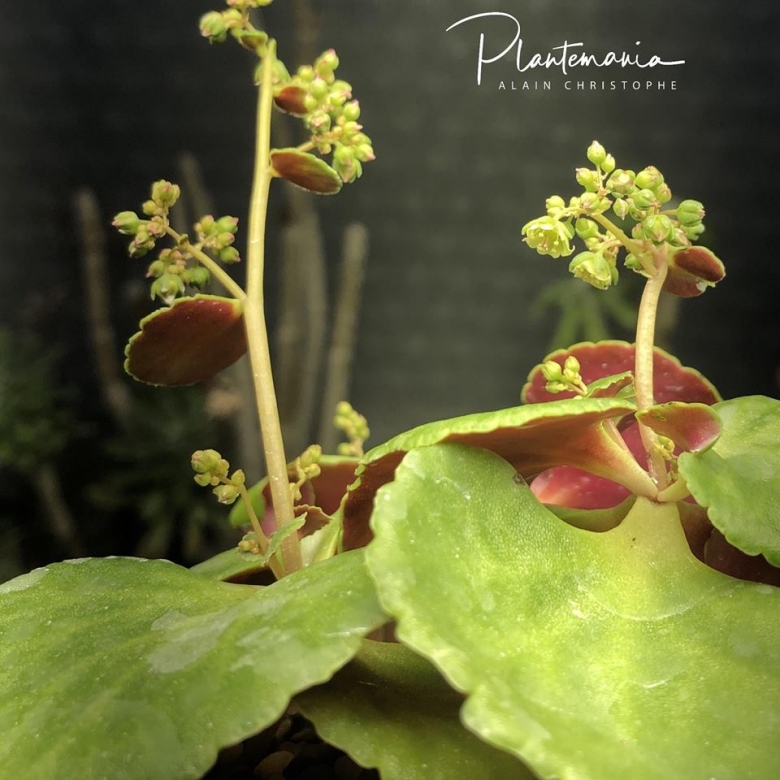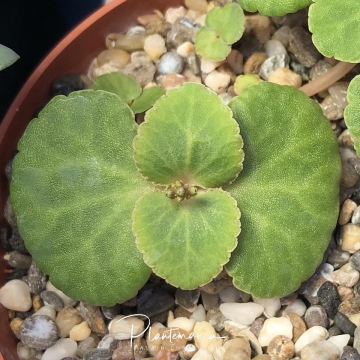
Crassula capensis Photo by: © Plantemania
Origin and Habitat: Crassula capensisSN|35497]]SN|35497]] is endemic to the Western Cape (near the coast from Clanwilliam and the Cape Peninsula in the west to around the southern Cape town of Riversdale in the east), South Africa.
Habitat and Ecology: Fynbos. This species grows on gravelly slopes, usually exposed, even on Table Mountain where damp spots among the crags are seasonally plentiful, or in moist, sheltered places under overhanging rocks. The habitat of this species and the environment is characterised by a number of stress factors such as summer drought, low soil fertility and periodic fires. The fires have a frequency of 4 to 40 years and are a natural phenomenon in fynbos. Fire provides the major cues for germination in the wild and the tubers, not destroyed by the fire, prosper from winter rain. Nutrients obtained from the ashes and the removal of some large shrubs that previously dominated the space, contribute to the good life. Moreover it is stimulated by veld fires resulting in larger flowers. Flowers are produced from autumn to early summer. Crassula capensisSN|35497]]SN|35497]] is widespread and not in danger of extinction, but habitat loss to urban and agricultural expansion, as well as competition from alien invasive plants are potentially threats.
Synonyms:
See all synonyms of Crassula capensis
Common Names include:
ENGLISH: Cape snowdrop
AFRIKAANS (Afrikaans): skaamblommetjie
Description: The Cape snowdrop (Crassula capensis) is a tiny perennial geophyte with a delicate appearance and has two pairs of broad scarcely fleshy leaves close to the ground. It grows from a rhizome and several small tubers and may form small dense clumps through suckering. It is said that the plant reaches heights of 5-15 cm tall (20 cm in favourable conditions, although this is probably not often observed). Nodding, star-shaped flowers are borne in a terminal umbel, the peduncle 20-70 mm long.
Stem. Erect 50-150(-200) mm high, sometimes branched from base.
Rhizome: branched, with several globose tubers with fibrous adventitious roots.
Leaves: In 2,3(4) pairs developing before or during flowering. Usually only lower ones with petioles up to 20(-30) mm long. Lamina scarcely fleshy, flattened, obovate or elliptic, (10-)20-60(-80) mm long, (5-)15-50(-60) mm wide, obtuse rarely bluntly acute, crenate or doubly crenate, rarely serrate to entire, surface glabrous, green, rarely purple below. Base cuneate to cordate.
Inflorescence: Usually terminal, an umbellate to flat-topped thyrse, with peduncle 30-100(-130) mm long.
Flowers: Nodding, star-shaped, to 2 cm in diameter, white, or tinged pink. Calyx lobes (sepals) triangular-lanceolate, l-2(-3) mm long, glabrous, slightly fleshy, green often tinged red. Corolla star-shaped, 5-7(-12)- merous, scarcely fused at base, white or tinged pink, lobes lanceolate, 3-6(-8) mm long, tip sharply acute, spreading. Stamens with brown anthers.
Similar species: C. capensis is distinquished from Crassula saxifraga by its star-shaped flowers and by a few bracts subtending the branches of the subumbellate inflorescence.
Subspecies, varieties, forms and cultivars of plants belonging to the Crassula capensis group
 Crassula capensis (L.) Baill.: has two pairs of broad, scarcely fleshy leaves with crenate margins are close to the ground, the open, star-shaped flowers are borne in a terminal umbel, the peduncle 20-70 mm long. Distribution. RSA, Western Cape near the coast from Clanwilliam to Caledon.
Crassula capensis (L.) Baill.: has two pairs of broad, scarcely fleshy leaves with crenate margins are close to the ground, the open, star-shaped flowers are borne in a terminal umbel, the peduncle 20-70 mm long. Distribution. RSA, Western Cape near the coast from Clanwilliam to Caledon. - Crassula capensis var. albertiniae (Schönland) Toelken: it develops leaves at only after flowering and at soil-level, margin of leanves entire, slightly undulate when young, the peduncle is 30-150 mm long. Distribution. RSA, Western Cape from Caledon to Riversdale
- Crassula capensis var. promontorii (Schönland & Baker f.) Toelken: develops leaves before flowering, the leaves borne up to 50 mm above ground level, the inflorescence lacks an unbranched peduncle; occurs in shade on the Distribution. RSA, Western Cape in the western side of Table Mountain and Flout Bay Mountains.
Bibliography: Major references and further lectures
1) J.P. Roux, “Flora of Southern Africa” 2003
2) Urs Eggli “Illustrated Handbook of Succulent Plants: Crassulaceae” Springer Berlin Heidelberg, 05/Nov/2012J.P. Roux, “Flora of South Africa”, 2003
3) Goldblatt, P. and Manning, J.C. 2000. “Cape Plants: A conspectus of the Cape Flora of South Africa”. Strelitzia 9. National Botanical Institute, Cape Town.
4) Raimondo, D., von Staden, L., Foden, W., Victor, J.E., Helme, N.A., Turner, R.C., Kamundi, D.A. and Manyama, P.A. 2009. “Red List of South African Plants”. Strelitzia 25. South African National Biodiversity Institute, Pretoria.
5) Tölken, H.R. 1985. “Crassulaceae”. In: O.A. Leistner (ed). “Flora of southern Africa” 14,1:1-244. Botanical Research Institute, Pretoria.
6) van der Colff, D. 2015. Crassula capensis (L.) Baill. National Assessment: Red List of South African Plants version 2017.1. Accessed on 2018/11/13
7) Doreen Court, "Succulent Flora of Southern Africa" CRC Press, 01/June/2000
8) Ivan Latti, “Crassula capensis plants in comfort” in Operation Wild Flowers. Web: https://www.operationwildflower.org.za/index.php/albums/crassulas/crassula-capensis-cape-snowdrop-thabo-10-1964
9) (PDF) "Patterns in the seed germination response to smoke in plants from the Cape Floristic Region, South Africa". Available from: https://www.researchgate.net/publication/277939864_Patterns_in_the_seed_germination_response_to_smoke_in_plants_from_the_Cape_Floristic_Region_South_Africa [accessed Nov 18 2018].
 Crassula capensis Photo by: © Plantemania
Crassula capensis Photo by: © PlantemaniaSend a photo of this plant.The gallery now contains thousands of pictures, however it is possible to do even more. We are, of course, seeking photos of species not yet shown in the gallery but not only that, we are also looking for better pictures than those already present.
Read More... Cultivation and Propagation: Germination is significantly improved by smoke treatment.











